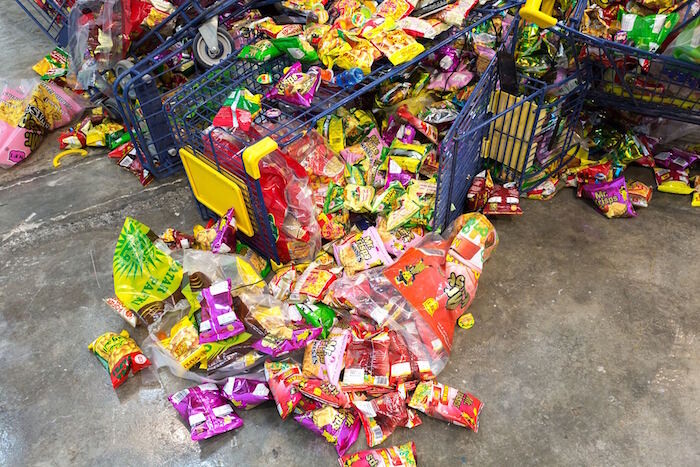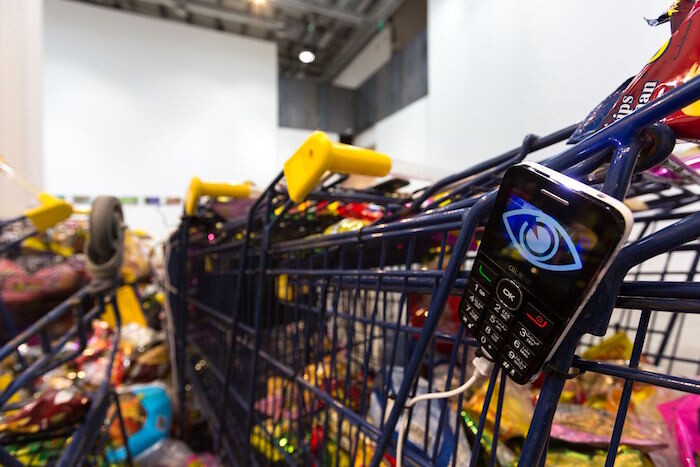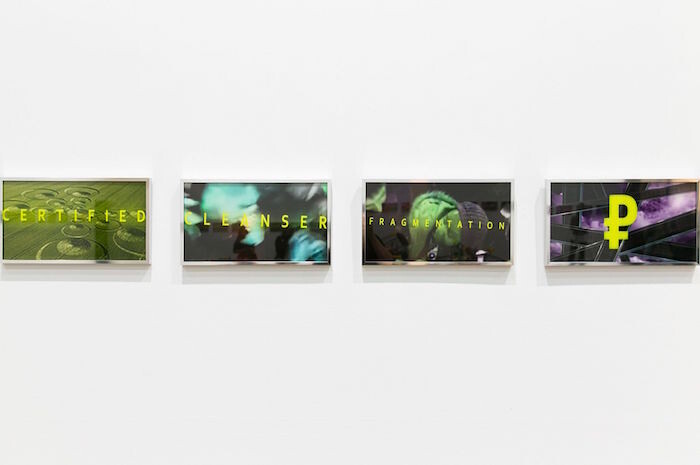Qatari-American artist Sophia Al-Maria has long examined the architecture, urban planning, and customs of what she calls “Gulf Futurism,” including the phenomenon of mall culture. Her solo show in Dubai presents a new iteration of works exhibited last year at the Whitney Museum, New York, which further that investigation.
The room-sized installation The Litany (2016) features supermarket trolleys (some upright, some overturned) huddled around the main gallery’s central column like a rugby scrum comprised of brightly colored metallic potato chip packets, cheap mobile phones, and mini jello snack pots. The brands presented here are iconic for those who grew up in the Gulf. Labels such as Mr Krisp and Ali Baba evoke a kitsch nostalgic throwback to 1990s childhoods, and their jewel wrapper colors give the installation the appearance of a candy pile. This cluster is surrounded by a hundred or so digital prints of stills from the digital videos playing on the phones, with phrases including “Panic,” “Teargas Toner,” “Methane Gel,” and “Post-Truth Plumper” emblazoned on garish backgrounds.
A dark cavern, semi-hidden in the corner of the space, houses the 16-minute video Black Friday (2016). Filmed amidst expanses of gleaming marble in one of Doha’s yet-to-open mega malls, Black Friday is accompanied by discordant music. The narrator, Sam Neill, tells the viewer that these are “not the dark satanic mills of the nineteenth century, but the bright fluorescent halls of the twenty-first.” Tinted in red, the hellish mallscape calls to mind T.S. Eliot’s “torchlight red on sweaty faces”1 as ominous blank mannequin heads distort and warp like a bad trip. Al-Maria’s flair for a dramatic turn of phrase toes the line between solemn and absurdly theatrical. It also helps ground The Litany, as Neil’s foreboding preaching makes all those myriad brash phrases and endless flashing phone consoles feel like so much empty prayer.
Al-Maria takes us on a trip into the twenty-first century’s temples to consumerism, the drone-filmed footage of ostentatious arches feeling more like the Hagia Sophia than a retail destination. Eventually we ascend from this reddish hell through a limbo of green and blue into a strange white afterlife. Yet, rather than offering comfort, this strange calm only furthers the sensation of isolation, and marble columns appear more sepulchral than soothing. Towards the end, a woman walks past us in slow motion, resplendent in a black flowing abaya (is she Virgil guiding Dante?). The trumpets return, but take on the aura of a revelation and redemption as we wander alongside her in abandoned expanses of white through “the frameless frame of forever.” At the conclusion of the video she collapses, sacrificed to the god of consumerism.
This journey ends with the artist’s own voice as she recalls shopping with her sister in a mall in Doha. Because Al-Maria was wearing her abaya, the American soldier in front of her did not recognize her as an old classmate from their childhood in the United States. Suspended in the vacuum of the mall, they are untethered from their original contexts, identities floating. The gulf Al-Maria feels between herself and her former classmate resonates within the mall, as a place stuck in “the miraculous present, where the ugly past meets an even uglier future.”
By showing this work for the first time in a commercial gallery, in a city that embodies shiny new Gulf consumerism, Al-Maria raises the issue of the viewer’s complicity in the systems she is critiquing. If consumerism is the enemy, should we then feel under any obligation to “consume”? Al-Maria goads us instead: everything must go, hurry, buy now, sell later. Are we in on the joke or are we just one of those aimless fools wandering the cavernous halls of commerce?
T.S. Eliot, “The Waste Land,” reprinted in T.S. Eliot, Selected Poems (London: Faber & Faber, 1976), 64.








